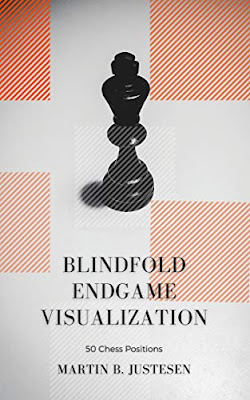Blindfold Endgame Visualisation
"I have always been impressed by strong chess players' ability to visualize the board without seeing it, firing off variations in the post-mortem, or walking away from the board during a game while thinking about the position. As an adult trying to master the game I really wanted to be able to improve my visualization skills.
However, I soon discovered that there wasn't much training material available."
- Martin Justesen
Happy New Year everybody.
First up, if you're here because of the Perpetual Chess Podcast Simple Chess episode - welcome. It's great to have you.
You can find my Simple Chess Study Companion Index here.
You may also be interested in the Beat the Masters series. These posts were the main reason why I started the blog in May 2020.
That said, let's get on.
My new Study Companion series for 2021 is going to be based on Martin Justesen’s Blindfold Endgame Visualisation - available on kindle or in paperback on amazon. There’s also a free sample available so you can try before you buy if you’re not sure.
There are 50 studies in the book. I’m going to look at one each week.
If you’ve never tried blindfold work before here are a few tips to help you on your way. Not that I’m an expert by any means but over the last couple of years I found out a few things just by trial and error.
1. Give it a go
I didn’t try doing any blindfold work at all until a couple of years ago.That’s about 30 years after I started playing chess. I don’t know why. I suppose I thought blindfold chess is something that only masters could do.
That’s just not true, and understanding that blindfold chess isn’t only our betters is the first step to improvement.
2. Give it another go
You might struggle at first. Don’t worry. It might not feel like it at first but playing chess blindfold is definitely something you get better at with practice.
3. Square colours
If you’re brand new to blindfold chess you might find calculating lines to be a big challenge at first. That’s not a problem. There’s still plenty you can do.
For example you can start by identifying the colour of the squares the pieces are on in the starting position.
4. Ask questions
Next you can begin asking yourself questions about the position. For example in Study One, are the White pawn and Black king on the same diagonal? If they are, how many squares are they apart. If not, where would you have to move the king to make it so?
The questions don’t matter, just make them up. Anything that makes you think about the position.
5. Can the pawn just run?
If you've got used to asking yourself about static features of the position, move on to questions about something that involves some movement - but that's easier that outright proving that White wins or draws. One good one for king and pawn endings where there's a passed pawn is can you just push it and make a queen. Here's a hint. It's a study so the answer is going to be NO. Still, working our where Black catches us is a good place to start visualising moving pieces.
6. Solving the study is just the goal, not the point of the activity
OK, we all want to solve every study, calculate every puzzle, win every game. If that’s our expectation, though, we’re likely to end up disappointed and frustrated. Nobody likes to fail. Since these feelings isn’t pleasant, sooner or later we’ll stop doing whatever brings it about.
If you’re new to solving studies blindfold the reality is you’re not going to get the right answer every time. Don’t worry, I won’t either. It doesn’t matter. Not even if you don’t solve any of them.
The point of doing this blindfold work isn’t to solve each study but to improve our visualisation skills. If we remember that, it’s easy to see that every study is a success just as long as we try to find the solution. Actually getting the right answer is irrelevant.
Keep track of your results if you want. Create a marking scheme where you award yourself marks out of five dependent on how much of the solution you saw if it floats your boat. Do either or both of those things ... just remember that the 'score' is just a trick to keep you motivated to work as hard as you can and now the end in and of itself.
Bear that in mind and, week in week out, just keep getting the work done.




A really interesting topic!
ReplyDeleteSo when folks use the term blindfold chess - how does it work for most people?
Can folks actually visualise and actually see the board and the pieces on it in their mind's eye in its entirety - is that an achievable goal even?
For me when I've tried this it seems more like solving a jigsaw puzzle in reverse based on the moves played / the last square a piece was on and trying to visualise what a particular part of the 64 square board looks like in terms of how pieces / pawns are placed in that sector (even the notion of what colour squares are is indistinct to me) - and having pulled that visualisation (which is more like a perception of where things are) together trying to figure out my next move.
I am really curious what a top player 'sees' when they play blindfold and the extent to which lesser players can aspire to this or improve this ability.
Hello and thanks for dropping by.
DeleteI’ve got some comments on this coming up in future posts.
But I can say now I can’t see a whole board at all.